Sulphur On Alfalfa
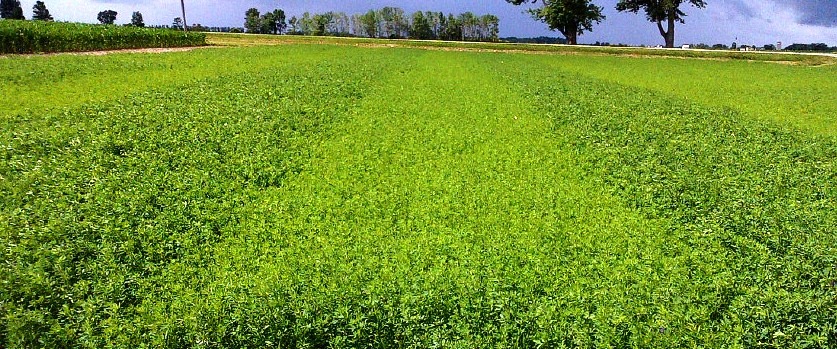
There are increasingly significant yield responses in Ontario when applying sulphur (S) to alfalfa and alfalfa-grass mixtures. Forage grasses also appear to have a yield response to adequate sulphur fertility. Consider sulphur in your forage fertility plans.
Sulphur (S) received from atmospheric sulphur dioxide emissions (acid rain) has steadily declined by over 50% during the last 25 years. S deficiencies have also increased due to some reductions in organic matter, and higher crop and protein yields. Alfalfa has the highest S requirements of any of the field crops. S is a constituent of 2 of the 21 amino acids that form protein, and is involved in nitrogen fixation. A 4 ton/acre crop of alfalfa removes about 20 lbs/ac of S.
Soil organic matter plays an important role in providing available S to plants. There is considerable S in manure. S deficiencies are more likely to occur on low organic matter soils, and soils that have not had a manure application within a couple of years.
S availability varies from site-to-site and from year-to-year according to temperature and rainfall. Sulphate is very mobile in soils, similar to nitrate, and can be leached into the subsoil and become unavailable to plants (but not as easily as nitrate).
What Does S Deficiency In Alfalfa Look Like?
Within fields, sulphur deficiency symptoms may first show up as yellow, stunted patches on eroded knolls and other low organic matter areas. S deficient alfalfa plants will be spindly and uniformly light green or yellowish (as opposed to a yellow top and green bottom, etc), with weak growth. (Figure 1)
How Do I Know If Have A Deficiency?
There currently is not a reliable soil test for S in Ontario. Soil sulphate levels are quite variable, and may be leached from the soil between soil sampling and plant growth.
Tissue testing of alfalfa (at mid-bud to early-flower stage) is considered a suitable diagnostic approach for determining S deficiencies. Sample the top 6 inches of 35 – 40 stems, let them dry, and send them to a laboratory for tissue analysis. The critical level below which alfalfa is considered S deficient and therefore may benefit from applying sulphur is 0.25%. If a check is desired, take a similar sample from an area with no visual S-deficiency symptoms.
A 2012 field survey of Ontario alfalfa stands indicated that 21% of fields had S- tissue analysis below this critical 0.25% level. It is also noteworthy that 37% of these fields tested below the critical K value of 1.7%, almost twice as many than were S deficient. Neglecting K fertility, while attempting to improve S fertility is not an effective strategy.
What Form of Sulphur?
What is the best source of S to use with alfalfa? Keep in mind that the sulphur must be in the sulphate form to be taken up and used by the plant.
1. Sulphate Sulphur
These fertilizers include:
- ammonium sulphate (21 – 0 – 0 – 24)
- potassium sulphate (0 – 0 – 50 – 18)
- sulphate of potash magnesia (Sul-Po-Mag or K-Mag) (0 – 0 – 22 – 20)
- calcium sulphate (gypsum) (0 – 0 – 0 – 17)
All are equally effective as sources of sulphate. Depending on what assumptions you make, current prices make S in the sulphate form worth about $1.00 or more per lb S. To determine the most economical source of sulphate, get some local price quotes and do the math.
Ammonium sulphate provides nitrogen which should not be needed by the alfalfa, but it is still usually an economic source of sulphate. K-mag and potassium sulphate also provide potassium which is usually also required in alfalfa, but potassium sulphate is difficult to source and more expensive in some areas. Gypsum can be a good source of sulphate, but has no advantage in improving soil pH. Thiosulphate liquid forms, ammonium thiosulphate (12-0-0-26) and potassium thiosulphate (0-0-25-17), are readily available, but liquids are less convenient for fertilizing alfalfa and generally more costly per unit of S than dry forms.
2. Elemental sulphur (0-0-0-90)
Elemental sulphur consists of finely ground sulphur that has been pelletized, and must be converted by oxidation to sulphate by soil bacteria before plants can utilize it. The rate of availability depends on particle size, method of application, soil temperature and moisture. Incorporating it into the soil before establishment makes it more readily available. In some circumstances, up to 50% of the sulphur may be available in the year of application, while the remainder is more slowly available.
Elemental sulphur is currently worth about $0.35 per lb of S. Although it is less precise, applying a single application of elemental sulphur rather than sulphate, supplies a cheaper S source over a longer period of time and reduces the need for annual applications. An application of 50 lbs/ac of elemental sulphur should last the life of a productive 3 year alfalfa stand.
When Should I Apply It?
Sulphate should ideally be applied in the spring at green-up to improve plant utilization, minimize losses due to leaching, and receive a first-cut yield boost (Figure 2). A spring application rate of 85 lbs/acre of ammonium sulphate will provide 20 lbs of sulphur. If sulphur deficiency is diagnosed after first-cut, a half rate of about 40-45 lbs/acre of ammonium sulphate, applied immediately after the first-cut is harvested, should provide adequate sulphur for the rest of the season.
Elemental sulphur can be applied by:
incorporating it into the soil with other fertilizer before establishment (Figure 3) , or
blending it with P and K (and possibly boron) and broadcasting it after a cut.
Keep in mind that elemental sulphur needs to be converted by soil microbes to sulphate in order to be used by plants, so it will not be immediately available.
How Much S Should I Apply?
A general thumb rule for S application on alfalfa is 5 lb/ac per ton of dry matter yield. Some S is still available in reduced amounts from atmospheric deposition and organic matter. The University of Wisconsin recommends 15 – 25 lbs/ac of S in the sulphate form broadcast on established stands annually, or 25 – 50 lbs/ac of elemental S incorporated at seeding. Research is required to verify these numbers in Ontario. Although there is little research, field experience suggests that as a rule of thumb, grass stands should receive nitrogen and sulphur in a ratio of about 10 to 1.
Ontario Research
in the past, sulphur deficiencies in alfalfa have been more common in the mid-western US and north-western Ontario, because they are located upwind of much of the sulphur producing industrial pollution that has been cleaned up. Ontario research on sulphur rates, source, and timing for alfalfa has been more limited. Results from recent research trials applying sulphate to alfalfa have been mixed. Some sites have shown no response to applying sulphur. However, the most responsive site showed a dramatic yield increase in an alfalfa-grass mix of 1.55 ton/ac, a crude protein increase of 4 percentage points, and a percentage of alfalfa in the harvested forage improved from 33 to 56%.
To confirm that an actual yield response has occurred, farmers may want to leave a test strip where no S is applied. (Figures 4 & 5)
Bottom Line
Tissue test alfalfa fields showing potential deficiency symptoms to determine if S should be applied, especially fields with low organic matter soils and those that do not receive manure. Spring applications of sulphate provide a more immediate, precise yield response. Applying elemental-S bulk blended with other fertilizer is a cost effective longer term method of providing S.
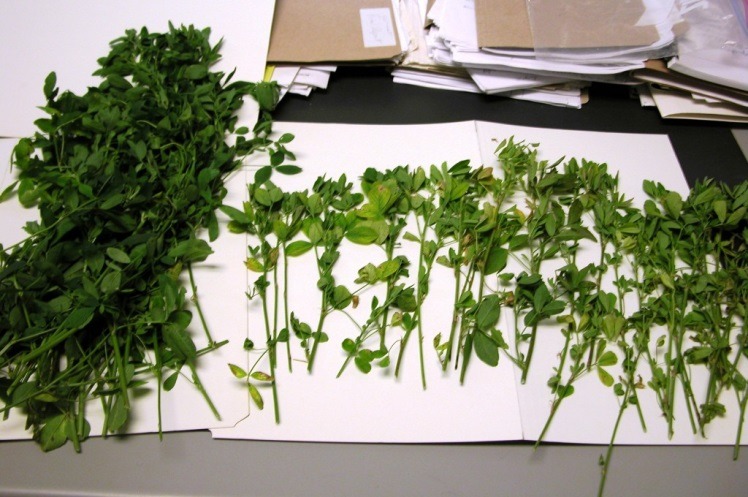

Figure 1 – S Deficiency Symptoms In Alfalfa. (Photo credit to OMAFRA)
Left – normal alfalfa stems with tissue test 0.34% S
Right – S deficient with tissue test 0.18% S, light green, spindly
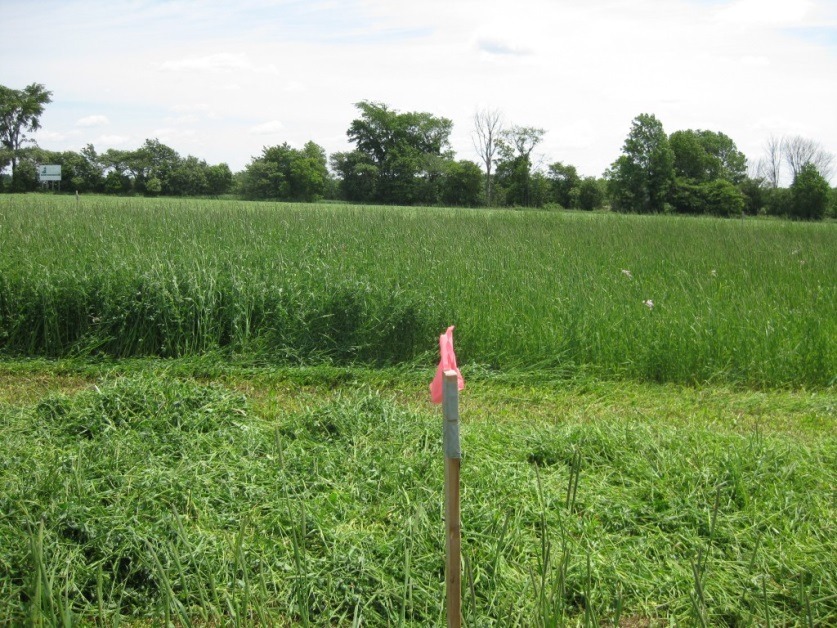

Figure 2 – Response of alfalfa to a spring potassium sulphate application, (left of stake) (Photo credit to OMAFRA)
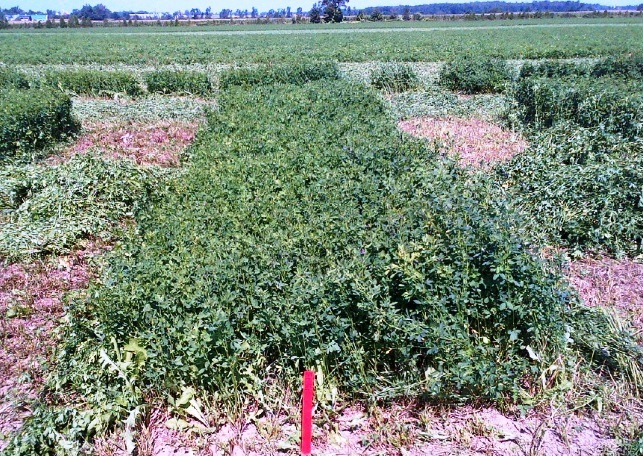

Figure 3 – Response of alfalfa to elemental-S broadcast in the fall previous to spring establishment (right of stake). (Photo credit to OMAFRA)


Figure 4 – Response from potassium sulphate applied to alfalfa following 1st cut. Elora Research Station, University of Guelph
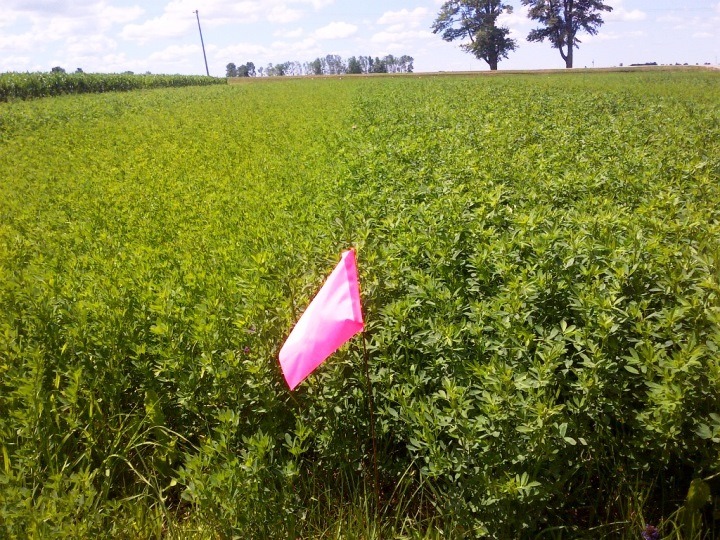

Figure 5 – Sulphate on alfalfa (right) vs no sulphur (left).
